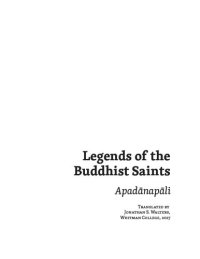
Ebook: Legends of the Buddhist Saints: Apadānapāli
Author: Jonathan S. Walters
- Genre: Religion // Buddhism
- Series: Apadāna (Khuddaka Nikaya of the Pāli Canon)
- Year: 2017
- Publisher: Whitman College
- City: Walla Walla, Washington
- Language: English
- epub
The Apadāna is a collection of biographical stories found in the Khuddaka Nikaya of the Pāli Canon, the scriptures of Theravada Buddhism. G.P. Malalasekera describes it as ''a Buddhist Vitae Sanctorum'' of Buddhist monks and nuns who lived during the lifetime of the Buddha.
It is thought to be one of the latest additions to the canon. The exact meaning of the title Apadāna is not known. Perhaps it means 'life history' or 'legend'. In Pāli it has the additional, older meaning of advice or moral instruction. Dr Sally Cutler has suggested the word originally meant 'reapings', i.e. of the results of karma. The title is sometimes translated as the Biographical Stories, or simply as The Stories.
The Apadāna consists of about 600 poems (between 589 and 603 in different editions), mostly biographical stories of senior Buddhist monks and nuns, but also of Buddhas and solitary Buddhas. Many of the stories of monks and nuns are expansions of, or otherwise related to, verses presented in the Theragatha and Therigatha as having been spoken by senior members of the early Sangha. The Apadāna is parallel to the Jātaka commentary, in which the Buddha recounts his previous lives.
Most Apadāna stories follow a fairly predictable outline, in which the speaker recounts their meritorious deeds in previous births as ethical individuals in a variety of different circumstances in different parts of India, before finally recounting the story of their present birth and how they came to be disciples of the Buddha. These stories of the previous lives of famous and not so famous monks and nuns may have been meant to provide moral examples to lay followers who wished to live as Buddhists but were unable or unwilling to undertake ordination as bhikkhus or bhikkhunis.
The text is divided into four sections:
1. Buddha-apadāna: A praise of the previous Buddhas and their Buddha fields (buddhakkhetta). 1 chapter of 82 verses (in the Burmese Sixth Council edition)
2. Paccekabuddha-apadāna: Ānanda questions the Buddha about the enlightenment of solitary Buddhas (paccekabuddha). 1 chapter of 47 verses.
3. Thera-apadāna: 55 chapters of 10 apadānas of senior monks. In total 547 verses.
4. Therī-apadāna: 4 chapters of 10 apadānas of senior nuns. In total 40 verses.
It is thought to be one of the latest additions to the canon. The exact meaning of the title Apadāna is not known. Perhaps it means 'life history' or 'legend'. In Pāli it has the additional, older meaning of advice or moral instruction. Dr Sally Cutler has suggested the word originally meant 'reapings', i.e. of the results of karma. The title is sometimes translated as the Biographical Stories, or simply as The Stories.
The Apadāna consists of about 600 poems (between 589 and 603 in different editions), mostly biographical stories of senior Buddhist monks and nuns, but also of Buddhas and solitary Buddhas. Many of the stories of monks and nuns are expansions of, or otherwise related to, verses presented in the Theragatha and Therigatha as having been spoken by senior members of the early Sangha. The Apadāna is parallel to the Jātaka commentary, in which the Buddha recounts his previous lives.
Most Apadāna stories follow a fairly predictable outline, in which the speaker recounts their meritorious deeds in previous births as ethical individuals in a variety of different circumstances in different parts of India, before finally recounting the story of their present birth and how they came to be disciples of the Buddha. These stories of the previous lives of famous and not so famous monks and nuns may have been meant to provide moral examples to lay followers who wished to live as Buddhists but were unable or unwilling to undertake ordination as bhikkhus or bhikkhunis.
The text is divided into four sections:
1. Buddha-apadāna: A praise of the previous Buddhas and their Buddha fields (buddhakkhetta). 1 chapter of 82 verses (in the Burmese Sixth Council edition)
2. Paccekabuddha-apadāna: Ānanda questions the Buddha about the enlightenment of solitary Buddhas (paccekabuddha). 1 chapter of 47 verses.
3. Thera-apadāna: 55 chapters of 10 apadānas of senior monks. In total 547 verses.
4. Therī-apadāna: 4 chapters of 10 apadānas of senior nuns. In total 40 verses.
Download the book Legends of the Buddhist Saints: Apadānapāli for free or read online
Continue reading on any device:

Last viewed books
Related books
{related-news}
Comments (0)